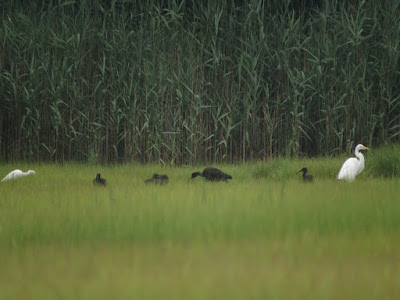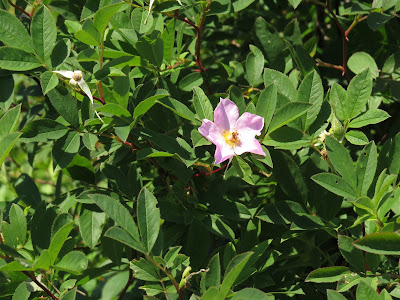The humidity hits me the second I step out the door. For a couple days, we have very pleasant summer weather, but this morning feels like the day will become a cooker. I set out for the East River, one of the best day trip rivers in close range.
I put in at the old stage ford. The tide is dropping, but there is still a good depth. If the weather report holds true, I'll paddle down river on the ebb tide and return against a lessening current with the wind at my back. There is no one around other than a dog walker that happens by just as I set out. The humidity is no longer any bother, it is exceptionally still and peaceful.I duck the branches of a fallen tree and the show starts. After the first bend is the first Great Blue Heron. There will be five more before I get to the Clapboard Hill Road bridge. I spot a couple of Osprey and an unidentified Hawk crosses in front of me. Right now, most of the birds are perched, possibly waiting for the tide to expose more of the silty shoreline.
Exiting the last of the Big Bends, a juvenile Night Heron crosses the river. This is a less than normal sighting and I wonder where it came from. They are common near my house because there is a very productive rookery on nearby Charles Island. There are a good many Great Egrets and Snowy Egrets.
The water is already too low to make a pass through the Sneak, so I stay to the main river. I've walked out of the Sneak before, and it is no fun. Although the spartina is easy walking, it is a gut buster to get up the soft muddy silt bank. I go all the way to the Sound. There is an Oyster Catcher feeding there. Otherwise, a couple dozen Gulls, including one of the black-headed Gulls, although there are three different species that it could be.
I head back against the current with a light wind behind me. The wind does little other than take some of the heat, and it is getting on toward the predicted 85F.
The activity is all up in the forested section above Clapboard Hill Road. There are several Osprey in the air along with three Hawks. The Egrets are down at the water's edge stabbing at food. I clear the Gravel Flats without having to wade, but just barely. When I turn the last bend, I find a whitetail fawn wading in the river and looking back at me. After sizing me up, it runs a short stretch up river, crosses at a shallow spot and heads off into the trees. Meanwhile, a pair of Kingfishers make several dives after tiny fingerling fish that are schooling amongst the boulders and deadfall trees.







































